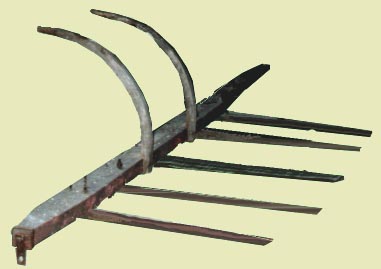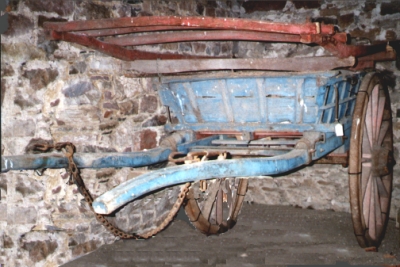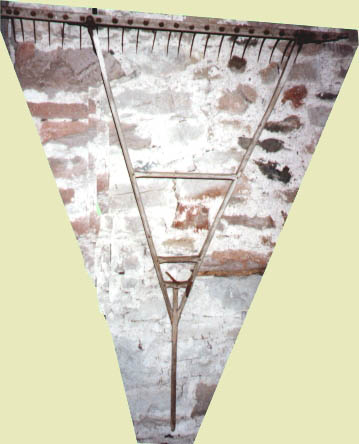Sweeping the hay

David Trotter: "When I first left school, early fifties it would be, your hay was put loose in, a lot of it was, them pickup balers were only just coming in. One or two contractors used to bring a big stationary baler in, just through the gate into the field, and they used to sweep the hay out the meadow - those big wooden hay sweeps, you swept it to and then you forked it in."
In a time of uncertain weather ("unsettled and changeable" as the forecasters like to say) you swept the hay together and heaped it to make cocks - little hay stacks that could stand a bit of weather until the whole crop could be taken home. This method was in frequent use in the more hilly areas with small fields and more likelihood of rain. In good weather and on flat land however, the new hay could be cleared straight from its windrows.
The wooden hay sweep was an American invention brought to England in the 1880s. Like many implements it had its good and its bad points. The Tumbling Tam or Tumbling Tommy haysweep was used with a single steady, fast walking horse hitched with very long chains, using the revolving lugs at each end of the long beam. The hay was swept up from the field, running in stretches back to where the haycart stood. As the haysweep travelled it scooped up the hay in a mounting pile.
When it was full the driver brought it to the cart and threw the handles upward, letting the horse go on walking. The sweep somersaulted forward and "leapt" over its dropped load of hay, righted itself and was ready to collect the next load. The driver walked over or round the pile of hay, caught up the handles, and went on with the horse to sweep another lot.
Meanwhile the men with the cart were forking the hay from the swept load up onto the cart.

David Trotter: "Then you loosed it in to a cart, with the hay shilvins (shelving) on, like that cart in the barn. Every cart had to have shilvins on, so you could get a bigger load on you see, just forked in.
"Each farm had so many men used to come and help - and they just used to fork it, go down the rows - put a fork in [under] it and run it, and put it to the fellow on the cart, and he would load it.
"As you scraped it up, the wife or the daughter would come along wi’t rake, down each side, and then just pull it in, and you picked that up next time, there was nothing wasted at all like."
So that big hay rake hanging on the wall, the women used that?

"That’s right. That was the womenfolk’s job, sort of following on. Then it would be taken down to the barn, unloaded, and put onto the moo (mew = indoor stack) for in winter."
The rake has iron teeth and is five feet wide. It was used to collect up hay into wind-rows and then into cocks for the night, so that the dew did not undo the drying of the previous day. Raking hay that had been missed by the hay sweep was "women’s work".
It was also used to collect cut stalks of corn missed in the first binding.